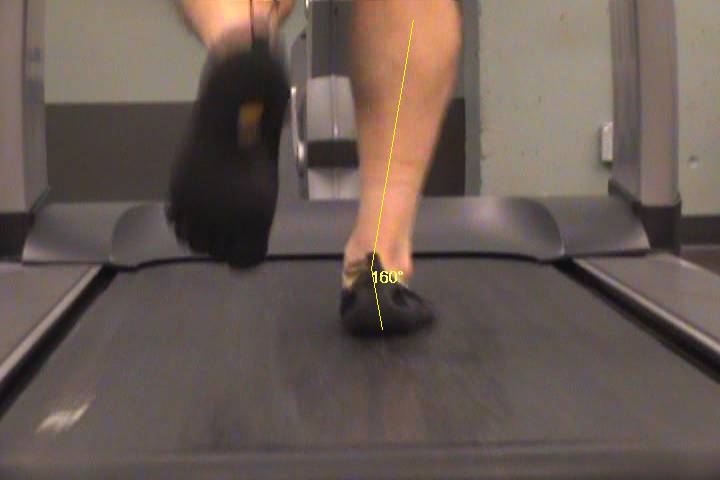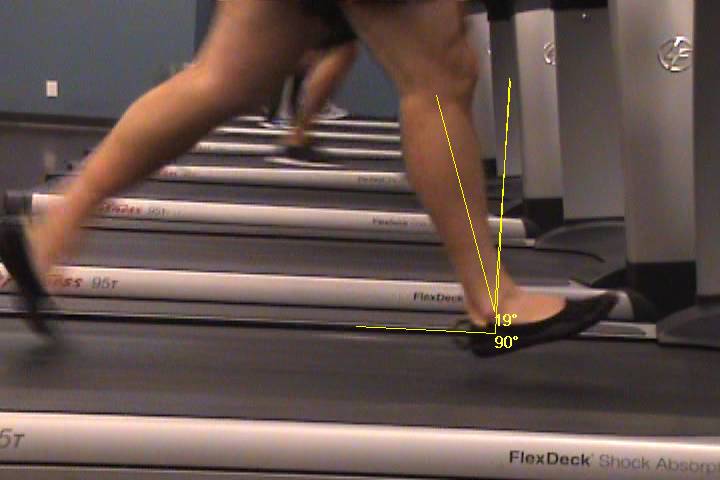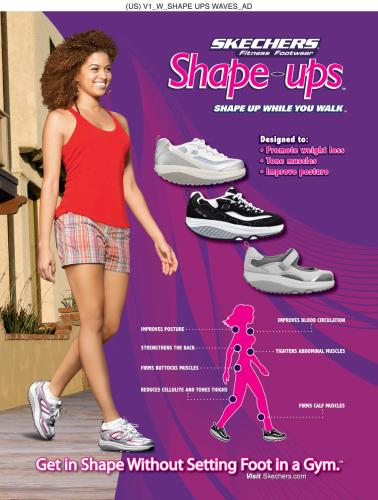Why You Should NEVER Run Barefoot, Incuding Vibrams
In a recent post I showed some of the research behind barefoot running and the effects of what Vibram Five Fingers would have on the foot during running. This week, Rick, one of my amazing clients, became the first to volunteer to participate in my attempt at scientific research and run on a treadmill while being video taped wearing both his normal runners and a pair of his Vibrams to see what would happen with his foot motion. Admittedly, this is just one participant and should not be construed as valid scientific literature, but hey, you have to start somewhere, and no better place than with a case study!!! Hells Yeah, baby!!!!!
So here’s the design: Rick ran for three minutes in both the regular shoes and the Vibrams for 2 consecutive times and an average of foot pronation in both feet was determined using a digital video analysis software package to measure joint angles in a frame-by-frame setting. Pretty cool, huh?? You want to make out with me now, don’t you?? No? Well, I guess that’s cool. **Insert awkward pause** …….So….how ’bout them Oilers?
Rick ran on a treadmill at a self-selected pace of 6.5 miles per hour in both types of shoes, and his heart rate didn’t change between the two (average of 174 in each footwear), suggesting there was minimal benefit to either footwear on his cardiopulmonary load (the shoes won’t make you run faster or make it easier on your O2 carrying capacity to do work).
Here’s the video showing the foot motion…
See a difference? Check this out. When wearing the shoes, he pronated an average of 15 degrees on his left foot and 14 degrees on his right, where in the Vibrams he pronated 19 degrees on his left and 20 degrees on his right (difference of 4 and 6 degrees respectively). The best part was when I measured the angular acceleration, or how fast his foot moved into pronation. While in shoes his right foot pronated at 120 degrees per second and his left at 70 degrees per second, where the Vibrams produced accelerations of 240 degrees per second on the left and 255 degrees per second n the right (an increase of more triple for the left foot and more than double for the right!!!). what this means is that the foot is being snapped into pronation much faster while wearing the Vibrams than in normal shoes, and this can actually lead to kinetic chain injuries through the foot, ankle, knee, hip and low back!!!!
Pretty ridiculous, right?? It gets even better!!!
When I looked at his view from the side, he showed he consciously changed his run style when wearing the Vibrams. In shoes, his foot strike was with a shin angle of 22 degrees ahead of vertical, and had a foot takeoff angle of 47 degrees (total leg angle of 69 degrees. Get your head out of the gutter!!). When he wore the Vibrams, he had a foot strike of a shin angle of 20 degrees ahead of vertical and a takeoff of 50 degrees (total leg angle of 70 degrees). The toe angle with shoes was also 32 degrees in shoes and 27 degrees in Vibrams. The leg angle was pretty similar, but the change in run stride technique was noticeable, and he said he felt like he was hitting the ground a lot harder in the Vibrams, and that was pretty uncomfortable during the run.
This change in run stride is consistent with the majority of the literature saying that people tend to run further up on their feet towards the ball of their foot, which adds more pressure to the plantar fascia and spring ligament of the foot, and creates a Muscle Imbalance of the foot.
So overall, I would not recommend the Vibrams for Rick to run in, as the footwear doesn’t protect him against the hard pronation and excessive ankle movement observed during the run. If he were to continue running in these shoes, he would probably wind up getting some sort of repetitive strain injury or stress fracture to his lower kinetic chain, it would just be a matter of where and how bad.
Please keep in mind this is just ONE person running on a treadmill, and isn’t saying Vibrams are bad for everyone. Each foot is different, and each run stride is different, so finding the footwear that’s appropriate for your foot is the biggest bang for your buck when finding footwear to run in. I do this with every one of my running clients and try to adjust their run technique as much as possible to get them running efficiently and fast with minimal strain on their bodies. To date, I haven’t had a single runner get any type of repetitive strain injury from following my recommendations, and I have some serious marathoners running some pretty ridiculously fast times, as well as beginners looking to hit personal bests. When I look at a foot hitting the ground in super slow motion, it becomes pretty clear whether it’s a good foot contact or not, and then we just make some adjustments to make it better. Pretty simple, right? Yeah, now you want to make out with me, don’t you?? No? Huh. ***Looks at floor and shuffles feet nervously*** …..So, yeah.
There was a book released a few years ago that extolled the benefits of running barefoot over running in conventional shoes saying it would reduce injuries and lead to a better run stride. What very few people are looking at the actual mechanics of the runners stride itself, which will contribute waaaaay more to running injuries than the shoe itself. That’s like taking someone who has a wicked hard slice on the golf course and expecting the new set of carbon fiber clubs to “sort out their swing” for them with absolutely no lessons on swing mechanics. Get me a set of those clubs and I’ll hit it like Tiger Woods circa 2007 (now I’m more like Tiger Woods circa late 2049).
Of course, the rationale being that one of the world record holders is able to run barefoot lends itself to the idea that everyone should be able to run barefoot. This is like saying everyone should be able to dunk a basketball because someone else can, or everyone should be able to throw a 90 mph fastball, or even run a marathon in the first place. Sounds kind of silly, doesn’t it? Again, every foot is different, and just because one or two people have success in them doesn’t mean you will.
I am all for Vibrams in a weight room, and find that wearing them gives me a better sense of balance and power development when performing heavy weight lifting, balancing or plyometric activities, but I think this is where their versatility ends. We are always surrounded by claims and suggestions that the newest product is the greatest thing since sliced bread…
…but we have to weigh them accordingly. Claims are great, but look for some actual measurements and scientific data before making a snap judgement and decide that the newest product out there is for you. Shapeups just got served by The American council on Exercise (ACE), showing that clinical data gave absolutely no benefit to wearing these layers of cushioning.
Oh, snap!!! No, ACE didn’t!!! Oh yes they did!!!
Now time for the big offer. If you have a pair of Vibrams and a video camera and want to have me check out your run stride, take a video like the one shown in both your Vibrams and your normal shoes, and I’ll check it out and send you a report on how your run stride works out and what the movement characteristics are like, as well as some feedback on how to improve your run. Don’t link a You Tube video to me, I need the actual video files. If you are interested in this, fire off an email to me at dsomerset@worldhealth.ca. Oh, by the way, since I’m such a fantastically cool guy, I’ll do this for free for the first 20 people who contact me about it. Pretty sweet, right??








19 Responses to Why You Should NEVER Run Barefoot, Incuding Vibrams